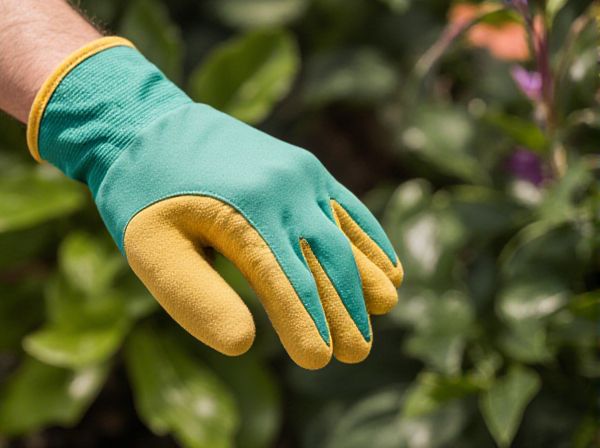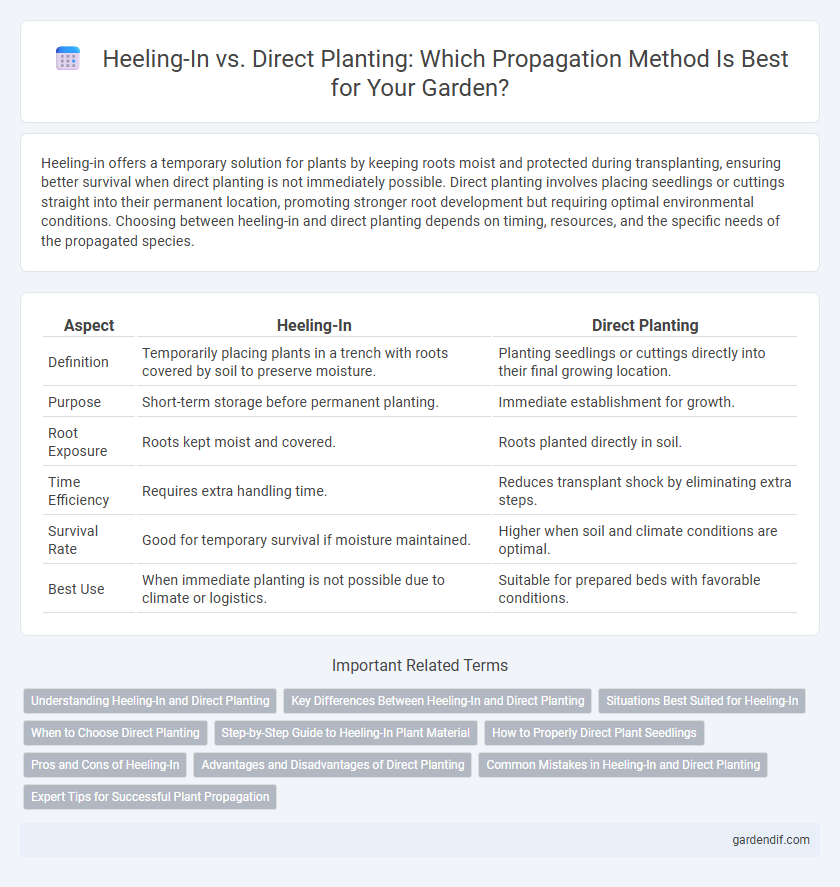
Heeling-in vs Direct planting Illustration
Heeling-in offers a temporary solution for plants by keeping roots moist and protected during transplanting, ensuring better survival when direct planting is not immediately possible. Direct planting involves placing seedlings or cuttings straight into their permanent location, promoting stronger root development but requiring optimal environmental conditions. Choosing between heeling-in and direct planting depends on timing, resources, and the specific needs of the propagated species.
Table of Comparison
| Aspect | Heeling-In | Direct Planting |
|---|---|---|
| Definition | Temporarily placing plants in a trench with roots covered by soil to preserve moisture. | Planting seedlings or cuttings directly into their final growing location. |
| Purpose | Short-term storage before permanent planting. | Immediate establishment for growth. |
| Root Exposure | Roots kept moist and covered. | Roots planted directly in soil. |
| Time Efficiency | Requires extra handling time. | Reduces transplant shock by eliminating extra steps. |
| Survival Rate | Good for temporary survival if moisture maintained. | Higher when soil and climate conditions are optimal. |
| Best Use | When immediate planting is not possible due to climate or logistics. | Suitable for prepared beds with favorable conditions. |
Understanding Heeling-In and Direct Planting
Heeling-in involves temporarily placing plants or cuttings in a protected environment with moist soil to maintain root moisture and prevent desiccation before final planting. Direct planting skips this intermediate step by placing plants immediately into their permanent location, reducing transplant shock but requiring optimal environmental conditions for success. Understanding the benefits of heeling-in helps ensure plant survival during delays, whereas direct planting is ideal for immediate growth with minimal handling.
Key Differences Between Heeling-In and Direct Planting
Heeling-in involves temporarily burying plants or cuttings in a protected environment to maintain moisture and root health before permanent planting, whereas direct planting places plants straight into their final growing location. Heeling-in allows for flexible timing and minimizes transplant shock by providing an intermediate recovery phase, unlike direct planting which requires immediate establishment and optimal site conditions. Key differences include propagation timing, root protection, and adaptability to environmental stresses, making heeling-in preferable for delicate or out-of-season plants.
Situations Best Suited for Heeling-In
Heeling-in is best suited for temporary plant storage during transplant delays or adverse weather conditions, providing moisture retention and root protection. It is ideal for seedlings, bare-root plants, or nursery stock awaiting permanent planting sites. This method prevents root desiccation and stress, ensuring plant viability in transitional phases.
When to Choose Direct Planting
Direct planting is ideal when immediate root establishment is crucial, such as in large-scale forestry or erosion control projects. It reduces transplant shock by allowing seedlings to grow in their final location from the start, promoting natural acclimatization to local soil and climate conditions. Selecting direct planting is advantageous for species with sensitive root systems or when nursery space and handling resources are limited.
Step-by-Step Guide to Heeling-In Plant Material
Heeling-in is a critical propagation technique involving temporarily planting seedlings or cuttings in a shallow trench filled with moist soil to maintain root moisture and prevent desiccation during transport or storage. Begin by selecting a well-drained, shaded site and preparing a trench deep enough to cover the root ball, then gently place the plants, ensuring roots are spread evenly and covered completely with soil. Maintain consistent moisture and aeration throughout the heeling-in period to promote root health before transferring plants to permanent locations or direct planting.
How to Properly Direct Plant Seedlings
To properly direct plant seedlings, choose healthy, well-developed plants with intact root systems and minimal transplant shock. Dig a hole slightly larger than the root ball, place the seedling at the same soil depth as it was grown in its container, and gently firm the soil around the roots to eliminate air pockets. Water thoroughly after planting to ensure good root-to-soil contact and promote rapid establishment.
Pros and Cons of Heeling-In
Heeling-in offers the advantage of temporarily protecting nursery stock by allowing roots to remain moist and undisturbed, which reduces transplant shock and extends storage time compared to direct planting. However, this method requires additional labor for proper setup and maintenance, and it can increase the risk of root damage or disease if moisture levels are not carefully managed. Unlike direct planting, heeling-in is less suitable for long-term propagation and demands more frequent monitoring to ensure plant health.
Advantages and Disadvantages of Direct Planting
Direct planting offers advantages such as reduced labor and time since seedlings are established immediately in the final location, promoting faster root adaptation and growth. However, disadvantages include higher vulnerability to environmental stresses and lower initial survival rates compared to heeling-in, which provides temporary protection and allows gradual acclimatization. Optimal success with direct planting depends on proper site preparation, timing, and post-planting care to mitigate these risks.
Common Mistakes in Heeling-In and Direct Planting
Common mistakes in heeling-in include improper soil moisture levels and insufficient root coverage, leading to plant desiccation or root damage. In direct planting, errors such as incorrect depth placement and inadequate soil compaction can hinder seedling establishment and root development. Both methods require careful attention to environmental conditions and soil preparation to ensure successful propagation.
Expert Tips for Successful Plant Propagation
Heeling-in involves temporarily planting young seedlings or cuttings closely together in a sheltered location to protect roots and maintain moisture, which is ideal for short-term propagation management. Direct planting bypasses this step by placing plants immediately into their final growing site, promoting faster establishment but requiring optimal site conditions and consistent care. Expert tips emphasize monitoring soil moisture, choosing disease-free material, and adjusting techniques based on plant species to enhance survival rates and growth success.
Heeling-in vs Direct planting Infographic

 gardendif.com
gardendif.com